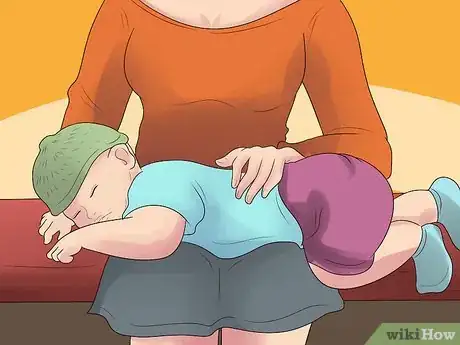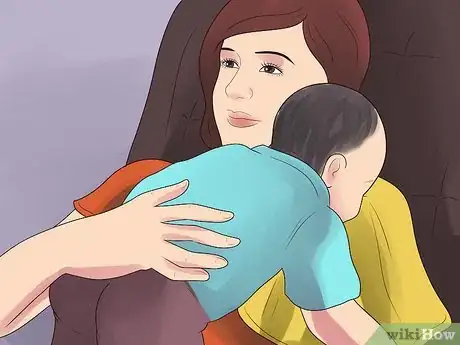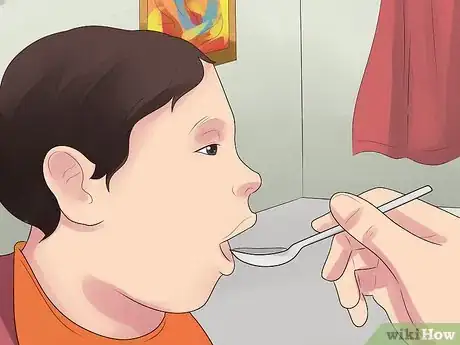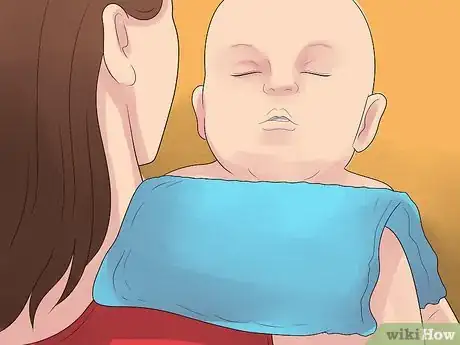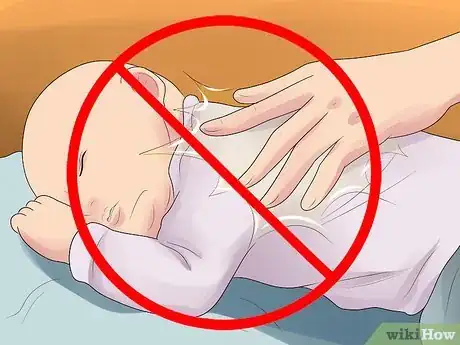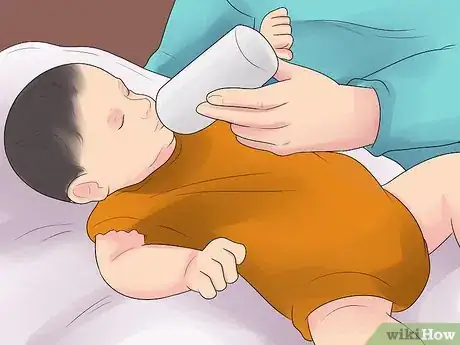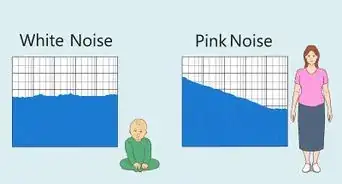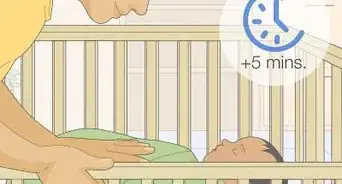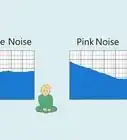This article was co-authored by Denise Stern. Denise Stern is a Parenting Specialist and the CEO of Let Mommy Sleep, the country’s leading Baby Nurse and Postpartum Care service. Denise specializes in providing nurturing care to newborns and evidence-based education to their parents. She holds a BA in Public Relations from North Carolina State University. Denise was the US Chamber of Commerce Leading Woman-Owned Business in 2013, a Washington FAMILY Magazine Mother of the Year in 2016, and on the elite White House Summit for Working Families hosted by the President and First Lady Obama in 2014. Let Mommy Sleep is the only company of its kind that holds a local government contract to teach newborn and postpartum care.
There are 9 references cited in this article, which can be found at the bottom of the page.
wikiHow marks an article as reader-approved once it receives enough positive feedback. This article has 15 testimonials from our readers, earning it our reader-approved status.
This article has been viewed 307,558 times.
When a baby burps, they release gas and feel more comfortable.[1] Most young babies who like to nurse at night often fall asleep while they are eating, but still, need to be burped. So, it's important to find a burping position that allows your baby to burp properly but doesn't wake them up. If you create the right environment for a good burp and find the right method for burping your baby based on their eating and sleeping patterns, you should have no trouble getting your sleeping baby to burp.
Steps
Choosing the Right Burping Method
-
1Hold your baby and burp them. This technique is good for babies who like to cuddle when they sleep. Slowly move your baby next to your body so you do not wake them up. Allow your baby’s head or chin to rest on your shoulder and cup their bottom to support them so they don’t slip as you hold them. [2]
- Place your other hand on their back and gently pat it to help them burp.
- If your baby has developed control of their head and neck, you can try to hold your baby at a slight distance from your shoulder to burp them. Position your baby’s tummy near your shoulder and gently press their tummy using your shoulder. Make sure your baby is still breathing comfortably and cup their bottom with one hand while placing the other hand on their back. Continue to gently press their tummy with your shoulder until they burp.
-
2Lay your baby down and burp them. This method is great if you are already lying next to your baby and feeding them, as all you need to do is pull your baby close and prop their head and tummy against your lap.[3]
- Place your baby on your lap, perpendicular to your body.
- Put their tummy on your leg and gently apply pressure to your baby’s tummy with your leg. Make sure your baby’s body is even across your legs so blood does not rush to their head.
- Tilt your baby’s head to one side so they can breathe properly even when they are lying on their tummy.
- Use your hand to support their head by placing your thumb and index finger on their jaw or chin, just below their ear. Do not place your hand against their neck or near their throat as you don’t want to choke your baby or constrict their breathing.
- Wait until your baby burps.
Advertisement -
3Lean your baby against your body. This technique works best for babies who like to sleep on their stomach and for heavy sleepers, as it can be difficult to get your baby into position without waking them up.
- First, lean back slightly against a comfortable chair or couch forming a 130 degrees angle. You can also use several pillows on your bed to elevate yourself instead of sitting on a chair or couch.
- Slowly lean your baby up against your body. Have them face down. Their head should be on your chest and their stomach should be against your stomach.
- Support their bottom with your hand and place your other hand on their back to gently pat them.
- Continue lightly patting your baby's back until they burp.
Creating an Ideal Burping Environment
-
1Feed your baby in a quiet, distraction-free room or area to cut down on their burps. Most babies are more likely to swallow air when they are distracted by loud noises or voices during feeding, which can cause them to become gassier and need to burp more often.
-
2Don’t be alarmed if your baby spits up as they burp. This is a common part of burping and occurs because the air in your baby’s stomach is usually trapped in the milk they just ate, so when the air comes out, the milk comes along with it. You may notice that milk also comes out of your baby’s nose. Spit up from the mouth and nose is a normal thing for many babies to do as they burp so don’t worry if this happens.
- Spit up can also be caused by reflux. Reflux occurs when milk and gastric juices flow back up from the baby’s tummy and come out of their mouth, resulting in the baby spitting up. If your baby keeps spitting up a large amount of milk, you may want to try the upright position of burping by holding your baby or leaning your baby to avoid milk from flowing back to their mouth.
- Your baby should outgrow spitting up when they reach 12 to 24 months of age.
-
3Put a clean cloth over your shoulder or chest as you burp your baby. This will help you avoid getting the baby’s spit-up on your clothes. You can also use the clean cloth to wipe your baby’s mouth and nose as you burp them.
-
4Avoid forcing your baby to burp if they seem comfortable after feeding. It’s okay if your baby does not burp after every feeding, as long as they appear comfortable and not gassy.[4] Your Baby may burp during their next feeding or burp more, which is fine.
- Always pat your baby gently on their back as your burp them as a hard or sharp pat does not encourage your baby to burp any faster or easier.
Understanding Your Baby’s Burping Habits
-
1Notice if your baby squirms or gets fussy while you feed them. Because most babies can’t just tell you when they need to burp, it’s important to pick up on your baby’s body language to recognize when they are gassy and need to burp. Most babies who need to be burped are typically squirmy during their feeding and get fussy, and visibly uncomfortable.[5]
- Burping is essential for infants as they need to let go of the gas in their bodies due to drinking milk. So, it is especially important to encourage them to burp when they fall asleep during their feeding.
- Most babies burp on their own at around two months old[6] and outgrow burping by around four to six months old, so you don’t need to worry about burping them after that point.[7]
-
2Keep track of your baby’s burps after feeding. Notice how frequently they need to be burped after each feeding. If your baby doesn’t burp much during they day, chances are you don’t need to worry about burping them at night.
- Most babies who eat at night don’t need to be burped because they nurse less anxiously at night and as a result, suck in less air.[8]
-
3Remember that some infants may burp more often than others. This could be because of the way they are being fed, as bottle fed infants usually swallow more air than those that breastfed, and will have more gas.
- In general, most breastfed babies need to be burped when you switch breasts and when the feeding is complete.[9] Bottle fed babies should generally be burped every two to three ounces of milk they drink.[10]
- If you are bottle feeding your baby, look for specialist feeding bottles that eliminate air during feeding, thereby lessening the amount of air being trapped inside your baby’s tummy.
Expert Q&A
-
QuestionWhat if my baby doesn't burp and falls asleep?
 Denise SternDenise Stern is a Parenting Specialist and the CEO of Let Mommy Sleep, the country’s leading Baby Nurse and Postpartum Care service. Denise specializes in providing nurturing care to newborns and evidence-based education to their parents. She holds a BA in Public Relations from North Carolina State University. Denise was the US Chamber of Commerce Leading Woman-Owned Business in 2013, a Washington FAMILY Magazine Mother of the Year in 2016, and on the elite White House Summit for Working Families hosted by the President and First Lady Obama in 2014. Let Mommy Sleep is the only company of its kind that holds a local government contract to teach newborn and postpartum care.
Denise SternDenise Stern is a Parenting Specialist and the CEO of Let Mommy Sleep, the country’s leading Baby Nurse and Postpartum Care service. Denise specializes in providing nurturing care to newborns and evidence-based education to their parents. She holds a BA in Public Relations from North Carolina State University. Denise was the US Chamber of Commerce Leading Woman-Owned Business in 2013, a Washington FAMILY Magazine Mother of the Year in 2016, and on the elite White House Summit for Working Families hosted by the President and First Lady Obama in 2014. Let Mommy Sleep is the only company of its kind that holds a local government contract to teach newborn and postpartum care.
Parenting Specialist If your baby is comfortable, then they may not need to burp and you don't have to wake them up.
If your baby is comfortable, then they may not need to burp and you don't have to wake them up.
References
- ↑ http://www.babycenter.com/0_how-to-burp-your-baby_10363676.bc
- ↑ Denise Stern. Parenting Specialist. Expert Interview. 19 February 2021
- ↑ https://www.askdrsears.com/topics/feeding-eating/feeding-infants-toddlers/nighttime-parenting/
- ↑ Denise Stern. Parenting Specialist. Expert Interview. 19 February 2021
- ↑ http://www.babycenter.com/0_how-to-burp-your-baby_10363676.bc
- ↑ http://www.webmd.com/parenting/baby/tc/burping-a-baby-topic-overview
- ↑ http://www.babycenter.com/0_how-to-burp-your-baby_10363676.bc
- ↑ https://www.askdrsears.com/topics/feeding-eating/feeding-infants-toddlers/nighttime-parenting/
- ↑ https://www.askdrsears.com/topics/feeding-eating/feeding-infants-toddlers/nighttime-parenting/
- ↑ http://www.healthychildren.org/English/ages-stages/baby/feeding-nutrition/Pages/Burping-Hiccups-and-Spitting-Up.aspx
- https://www.wikihow.com/Burp-Babies
- https://www.wikihow.mom/Burp-a-Newborn
- https://www.wikihow.com/Treat-Acid-Reflux-in-Newborns
- http://www.babycenter.com/0_how-to-burp-your-baby_10363676.bc
About This Article
To burp a sleeping baby, lay a clean cloth over your shoulder or chest and lean the baby against your body so that the baby’s head or chin rests on your shoulder. Next, cup their bottom with 1 hand to support their weight and gently pat the baby on the back with the other hand until they burp. Alternatively, you can place the baby face down on your lap so that their tummy is on top of your leg. Elevate the baby's head slightly so that it's higher than their stomach. Then, use your leg to gently apply pressure to their tummy, making sure to support the head by placing your thumb and index finger under the jaw or chin. For more advice, including how to create an ideal burping environment for your baby, keep reading!

